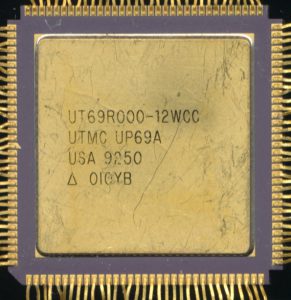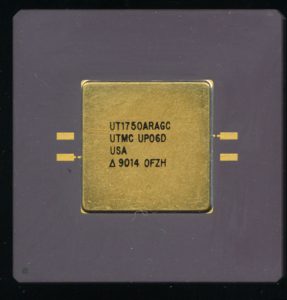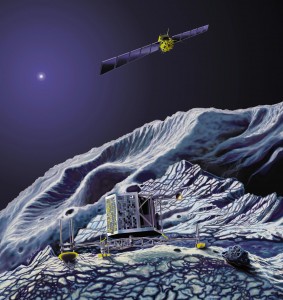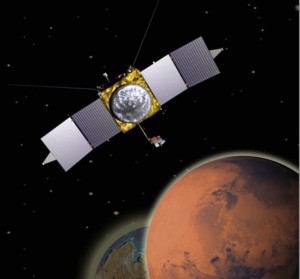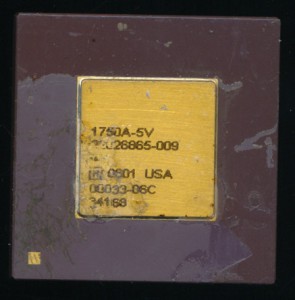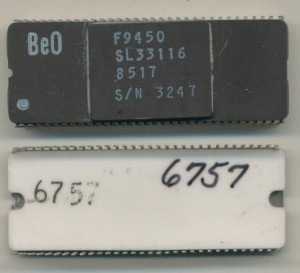CPU of the Day: UTMC UT69R000: The RISC with a Trick
We have previously covered several MIL-STD-1750A compatible processors as well as the history and design of them. As a reminder the 1750A standard is an Instruction Set Architecture, specifying exactly what instructions the processor must support, and how it should process interrupts etc. It is agnostic, meaning it doesn’t care. how that ISA is implemented, a designers can implement the design in CMOS, NMOS, Bipolar, or anything else needed to meet the physical needs, as long as it can process 1750A instructions.
Today we are going to look at the result of that by looking at a processor that ISN’T a 1750A design. That processor is a 16-bit RISC processor originally made by UTMC (United Technologies Microelectronics Center). UTMC was based in Colorado Springs, CO, and originally was formed to bring a semiconductor arm to United Technology, including their acquisition of Mostek, which later was sold to Thomson of France. After selling Mostek, UTMC focussed on the military/high reliability marked, making many ASICs and radhard parts including MIL-STD-1553 bus products and 1750A processors. The UT69R000 was designed in the late 1980’s for use in military and space applications and is a fairly classic RISC design with 20 16-bit registers, a 32-bit Accumulator, a 64K data space and a 1M address space. Internally it is built around a 32-bit ALU and can process instructions in 2 clock cycles, resulting in 8MIPS at 16MHz. The 69R000 is built on a 1.5u twin-well CMOS process that is designed to be radiation hardened (this isn’t your normal PC processor afterall). In 1998 UTMC sold its microelectronics division to Aeroflex, and today, it is part of the English company Cobham.
UTMC also made a 1750A processor, known as the UT1750AR, and if you might wonder why the ‘R’ is added at the end. The ‘R’ denotes that this 1750A has a RISC mode available. If the M1750 pin is tied high, the processor works as a 1750A processor, tied low, it runs in 16-bit RISC mode. How is this possible? Because the UT1750AR is a UT69R000 processor internally. Its the same die inside the package, and the pinout is almost the same (internally it may be but that’s hard to tell). In order for the UT1750AR to work as a 1750A it needs an 8Kx16 external ROM. This ROM (supplied by UTMC) includes translations from 1750A instructions to RISC macro-ops, not unlike how modern day processors handle x86. The processor receives a 1750A instruction, passes it to the ROM for translation, and then processes the result in its native RISC instructions. There is of course a performance penalty, processing code this way results in 1750A code execution rates of 0.8MIPS at 16MHz, a 90% performance hit over the native RISC. For comparison sake, the Fairchild F9450 processor, also a 1750A compatible CPU, executes around 1.5MIPS at 20MHz (clock for clock, about 30% faster), and thats in a power hungry Bipolar process, so the RISC translation isn’t terrible for most uses.
By today’s standards, even of space based processors, the UT69R000 is a bit underpowered, but it still has found wide use in space applications. Not as a main processor, but as a support processor, usually supporting equipment that needs to be always on, and always ready. One of the more famous mission the UT69R000 served on was powering the twin uplink computers for the DAWN asteroid mission (which only this year ended). It was also used on various instrumentation on the now retired Space Shuttles. The CPU also powered the camera system on the (also retired) Earth Observing-1 Satellite, taking stellar pictures of our planet for 16 years from 2000-2017. Another user is the NASA AIM satellite that explores clouds at the edge of space, originally designed to last a couple years, its mission which started in 2007 is still going. The
cameras providing the pretty pictures are powered by the UT69R000. A JAXA/ESA mission known as SOLAR-B/Hinode is also still flying and running a Sun observing telescope powered by the little RISC processor.
There are many many more missions and uses of the UT69R000, finding them all is a bit tricky, as rarely does a processor like this get any of the press, its almost always the Command/Data Processor, these days things like the BAE RAD750, and LEON SPARC processors, but for many things in space, and on Earth, 16-bits its all the RISC you need.
Tags:
MIL-STD-1750A, RISC, Space, UTMC
Posted in:
CPU of the Day


